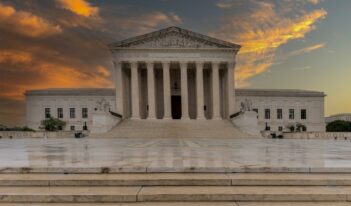
An uncertain future awaits the federal program designed to benefit children of immigrants.
In Department of Homeland Security v. Regents of the University of California, the U.S. Supreme Court declined to permit the Trump Administration to end the Deferred Action for Childhood Arrivals (DACA) program—at least for now. The decision effectively defers action on deferred action, temporarily continuing protection for recipients while providing a wide opening for the government to attempt rescission of the program again.
The Obama Administration created the DACA program by executive memorandum in June 2012 to protect from deportation certain Dreamers, or immigrants with clean records who were brought to the United States by their parents as children. The program also provides recipients with work authorization and a social security number. Recipients must renew their DACA status every two years.
The DACA program is very popular and supported by a broad majority of Americans, who generally believe that children brought to the United States by their parents should be able to live and work in the country they call home. But DACA is also a political flashpoint for immigration restrictionists, including those in the Trump Administration who have taken pains to stem lawful and unlawful immigration in every way imaginable. To put it lightly, “DACA presents a delicate political issue,” as Justice Samuel Alito acknowledged in his dissent.
In the DACA decision, the majority opinion did not address whether DACA was a lawful policy in the first place—the subject of Justice Clarence Thomas’s dissent—nor whether the program has merit as a humanitarian policy—the focus of many organizations supporting DACA. Instead, the Court analyzed three main questions: first, whether the U.S. Department of Homeland Security’s (DHS) rescission decision was judicially reviewable; second, whether the Trump Administration properly justified its decision; and third, whether the rescission created an equal protection violation.
The Court found that the DHS decision to end DACA was reviewable, falling within the presumption of reviewability created by the Administrative Procedure Act (APA).
DHS had argued that its action should be unreviewable under the “enforcement exception” created in Heckler v. Chaney, a 1985 Supreme Court decision. Chaney established the principle that individual-level government decisions not to enforce a law are within an agency’s discretionary power. Discretionary decisions are generally not reviewable for a “constellation of reasons,” including resource allocation and policy concerns.
Unlike the agency action at issue in Chaney, the Court found that DACA is more than a non-enforcement policy. Because DACA involves not only the non-action of deferring removal, but also the affirmative act of conferring benefits such as work authorization upon recipients, the Court held that the agency decision to rescind the program was judicially reviewable.
Before the Court could apply APA standards of review to the rescission, it addressed a critical preliminary question: Which of two government rescission memoranda were relevant for review?
Former Acting Secretary of Homeland Security Elaine Duke issued the first memo rescinding DACA—the Duke memo—in September 2017. Nine months later, then-Secretary Kirstjen Nielsen issued the second memo—the Nielson memo—in response to an order by a federal district court asking DHS for further explanation about the decision to rescind DACA.
In deciding which memoranda to consider, the Supreme Court invoked a bedrock principle of administrative law: judicial review of agency action is confined to the reasoning the agency offered “at the time of the agency action.” If that initial justification is inadequate, the agency can provide a fuller explanation of the contemporaneous reasoning for a decision. Alternatively, under SEC v. Chenery, an agency can start “afresh” by taking new agency action—which here would mean reissuing the DACA rescission altogether. These were the two options before the Trump Administration after lower courts had found that the explanation offered in the Duke memo would not suffice to justify the rescission decision.
Yet Nielsen took neither of the two options, a move that commentators have noted was incompetent.
Instead of reissuing the rescission or elaborating on the initial reasoning, the Nielsen memo essentially just reiterated the Duke memo’s unexplained conclusion that DACA was unlawful but then added two additional justifications which the government relied on during litigation. But because these added justifications advanced by Nielsen did not appear in the Duke memo, the Court found that the Nielsen memo contained only “impermissible post hoc rationalizations” rather than contemporaneous explanations for the original agency action. The Court declined to consider the Nielsen memo, with Chief Justice John Roberts noting that to do otherwise would allow DHS to “cut corners” in this critical case.
With only the Duke memo on the table, the Court next analyzed the substantive question of whether the rescission was arbitrary and capricious under the APA. On this question, the Court finally turned to the human side of DACA, noting that the rescission’s impact would “radiate outward” from DACA recipients to their families, employers, schools they attend, and the broader economy.
As required by the landmark case MVMA v. State Farm, the Court held that DHS could and should have better accounted for the interests of DACA stakeholders because DHS had the discretion to choose from a range of alternative policies when ending the program. Critically, Secretary Duke could have implemented, or at least considered, a policy that would end work authorization for DACA recipients but not end deferred removal. After all, the Duke memo was based on a U.S. Court of Appeals for the Fifth Circuit decision that only invalidated DHS’s granting of benefits in a related program—forbearance, or deferral, was never found to be a legal problem.
By failing to consider the option of retaining the deferral policy “at the heart of DACA,” or otherwise balancing the reliance interest against DACA’s possible legal flaws, Chief Justice Roberts’s majority opinion explained that the agency’s total rescission was arbitrary and capricious.
Finally, the Court found that the DACA rescission did not violate the equal protection guarantee of the Fifth Amendment of the U.S. Constitution. DACA advocates had argued that discriminatory animus contributed to the rescission decision, referring to the disparate impact of the rescission on the Mexican Latinx community as proof of such animus.
In denying this claim, the Court first opined that when a population makes up an “outsized share” of any immigration program, that group will naturally be more impacted. Although the challengers had cited the “unusual history” of DHS action leading up to the rescission, the Court found “nothing irregular” about it. The Court also rejected the challengers’ argument that statements made by President Donald J. Trump evidenced discriminatory intent against Latinos. The Court found that these statements did not create a valid equal protection claim because they did not arise in the specific context of the rescission action.
Justice Sonia Sotomayor issued a strong rebuke to all points of the majority’s equal protection analysis. In particular, she highlighted that the numerous anti-immigrant and anti-Latinx statements that President Trump has made, both as a candidate and after taking office, to show that the rescission decision “was ‘contaminated by impermissible discriminatory animus.’” Indeed, given the aggressive and frequent nature of the President’s racist tweets and comments, some commentators wonder whether equal protection could ever apply to the nation’s 60 million Latinos after this decision.
Ultimately, the DACA program lives to see another day. Another hurdle, however, may soon arise in the form of the Trump Administration’s renewed attempt to end the program. As dissenting Justice Brett Kavanaugh noted, “the only practical consequence of the Court’s decision to remand appears to be some delay.” Justice Kavanaugh suggested that if the government were to “relabel and reiterate” its explanation for the rescission decision, “perhaps with some elaboration as suggested in the Court’s opinion,” the Trump Administration could effectively terminate DACA.
Even without terminating the program, the Trump Administration may raise other roadblocks for DACA recipients. The Deputy Director for Policy Joseph Edlow issued an ominous statement in response to the Court’s DACA decision. “Today’s court opinion has no basis in law,” he wrote. The decision “merely delays the President’s lawful ability to end the illegal DACA amnesty program.”
Although the U.S. Citizenship and Immigration Services should begin to accept and process new DACA applications again for the first time in nearly three years, some new DACA applications have already been submitted and rejected. Following this apparent defiance of the Supreme Court’s ruling, a federal district court issued a decision explicitly stating that the Administration must restore DACA to its pre-September 2017 status, which means accepting new applications. Meanwhile, President Trump stated in a recent interview that he would introduce a bill or an executive order that would “take care” of DACA recipients.
DACA may still be saved, however. If elected, candidate and former Vice President Joe Biden has stated that he would not end DACA, and instead would send a bill to Congress “on day one” of his Administration to codify the program. Congressional action is the only way to make DACA permanent.
In the meantime, DACA recipients and their families still live with uncertainty. “What happens to a dream deferred?” asked Langston Hughes in his poem Harlem. We are still waiting to find out.
This essay is part of a series entitled The Supreme Court’s 2019-2020 Regulatory Term.




